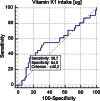Functional deficiency of vitamin K in hemodialysis patients in Upper Silesia in Poland
- PMID: 27000106
- PMCID: PMC4839038
- DOI: 10.1007/s11255-016-1255-6
Functional deficiency of vitamin K in hemodialysis patients in Upper Silesia in Poland
Abstract
Purpose: Functional vitamin K deficiency (both K1 and K2) is postulated to be one of the most relevant links between chronic kidney disease and vascular calcification in hemodialysis (HD) patients. Recommended dietary restrictions in HD patients superimposed on diversity of eating habits across the countries may affect the prevalence of functional vitamin K deficiency. The aim of this study was to determine the level of functional vitamin K deficiency and its relation to vitamin K1 intake in HD patients in Upper Silesia in Poland.
Methods: Protein-induced vitamin K absence or antagonist-II (PIVKA-II) and undercarboxylated matrix Gla protein (ucMGP) were assessed by ELISA in 153 stable, prevalent HD patients and 20 apparently healthy adults (to establish normal ranges for PIVKA-II and ucMGP). Daily phylloquinone intake was assessed using a food frequency questionnaire.
Results: PIVKA-II and ucMGP levels were increased in 27.5 and 77.1 % of HD patients in comparison with the reference ranges in apparently healthy controls, respectively. In 45 % of cases, the increased PIVKA-II level was explained by insufficient phylloquinone intake for Polish population (recommended intake: >55 μg for women and >65 µg for men). Applying ROC analysis, we showed that vitamin K1 intake below 40.2 µg/day was associated with increased PIVKA-II levels. There was no correlation between vitamin K1 intake and plasma concentration of ucMGP, or between PIVKA-II and ucMGP.
Conclusions: (1) Functional vitamin K1 deficiency is explained by low vitamin K1 intake in less than half of HD patients. (2) Undercarboxylated matrix Gla protein level is a poor surrogate for functional vitamin K1 deficiency.
Keywords: Hemodialysis; Nutrition; PIVKA-II; Undercarboxylated MGP; Vitamin K intake.
Figures
References
Publication types
MeSH terms
Substances
LinkOut - more resources
Full Text Sources
Other Literature Sources
Medical
Miscellaneous


